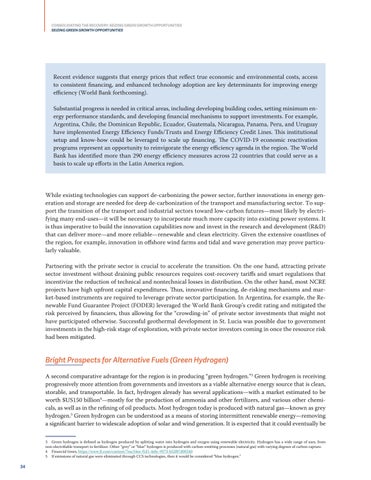Consolidating the Recovery: Seizing Green Growth Opportunities Seizing Green Growth Opportunities
Recent evidence suggests that energy prices that reflect true economic and environmental costs, access to consistent financing, and enhanced technology adoption are key determinants for improving energy efficiency (World Bank forthcoming). Substantial progress is needed in critical areas, including developing building codes, setting minimum energy performance standards, and developing financial mechanisms to support investments. For example, Argentina, Chile, the Dominican Republic, Ecuador, Guatemala, Nicaragua, Panama, Peru, and Uruguay have implemented Energy Efficiency Funds/Trusts and Energy Efficiency Credit Lines. This institutional setup and know-how could be leveraged to scale up financing. The COVID-19 economic reactivation programs represent an opportunity to reinvigorate the energy efficiency agenda in the region. The World Bank has identified more than 290 energy efficiency measures across 22 countries that could serve as a basis to scale up efforts in the Latin America region.
While existing technologies can support de-carbonizing the power sector, further innovations in energy generation and storage are needed for deep de-carbonization of the transport and manufacturing sector. To support the transition of the transport and industrial sectors toward low-carbon futures—most likely by electrifying many end-uses—it will be necessary to incorporate much more capacity into existing power systems. It is thus imperative to build the innovation capabilities now and invest in the research and development (R&D) that can deliver more—and more reliable—renewable and clean electricity. Given the extensive coastlines of the region, for example, innovation in offshore wind farms and tidal and wave generation may prove particularly valuable. Partnering with the private sector is crucial to accelerate the transition. On the one hand, attracting private sector investment without draining public resources requires cost-recovery tariffs and smart regulations that incentivize the reduction of technical and nontechnical losses in distribution. On the other hand, most NCRE projects have high upfront capital expenditures. Thus, innovative financing, de-risking mechanisms and market-based instruments are required to leverage private sector participation. In Argentina, for example, the Renewable Fund Guarantee Project (FODER) leveraged the World Bank Group’s credit rating and mitigated the risk perceived by financiers, thus allowing for the “crowding-in” of private sector investments that might not have participated otherwise. Successful geothermal development in St. Lucia was possible due to government investments in the high-risk stage of exploration, with private sector investors coming in once the resource risk had been mitigated.
Bright Prospects for Alternative Fuels (Green Hydrogen) A second comparative advantage for the region is in producing “green hydrogen.”3 Green hydrogen is receiving progressively more attention from governments and investors as a viable alternative energy source that is clean, storable, and transportable. In fact, hydrogen already has several applications—with a market estimated to be worth $US150 billion4—mostly for the production of ammonia and other fertilizers, and various other chemicals, as well as in the refining of oil products. Most hydrogen today is produced with natural gas—known as grey hydrogen.5 Green hydrogen can be understood as a means of storing intermittent renewable energy—removing a significant barrier to widescale adoption of solar and wind generation. It is expected that it could eventually be 3 Green hydrogen is defined as hydrogen produced by splitting water into hydrogen and oxygen using renewable electricity. Hydrogen has a wide range of uses, from non-electrifiable transport to fertilizer. Other “grey” or “blue” hydrogen is produced with carbon-emitting processes (natural gas) with varying degrees of carbon capture. 4 Financial times, https://www.ft.com/content/7eac54ee-f1d1-4ebc-9573-b52f87d00240 5 If emissions of natural gas were eliminated through CCS technologies, then it would be considered “blue hydrogen.”
34



